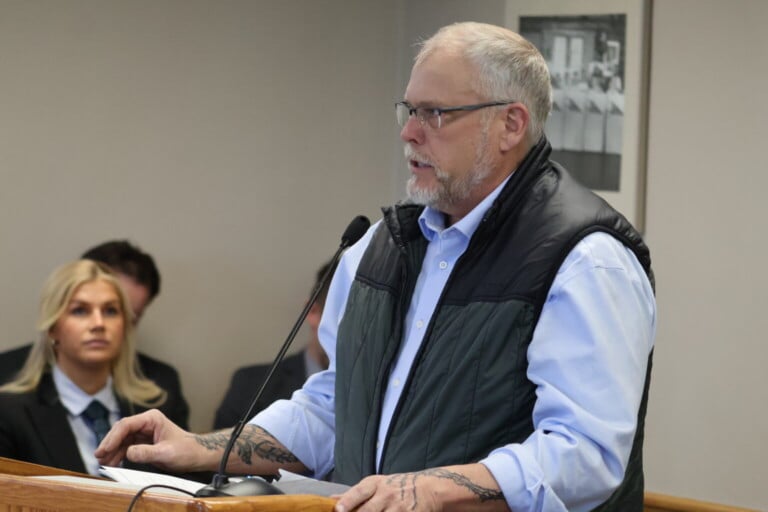North Dakota negotiated better terms with Summit. Some landowners say they didn’t get that chance.

BISMARCK, N.D. (North Dakota Monitor) — Landowners forced to participate in Summit Carbon Solutions’ planned carbon dioxide storage project in North Dakota are claiming the state received more favorable contract terms than private property owners were offered.
The state’s contract with Summit grants the company permission to store carbon dioxide under public lands and includes provisions for additional insurance and legal and environmental protections that were not granted to private landowners.
Some of these protections are similar to what private landowners asked for in a lease, but Summit wouldn’t negotiate their inclusion, attorney Derrick Braaten said.
“It’s sort of like salt in the wound, because we tried really hard to negotiate with them. They absolutely stonewalled us,” Braaten said. “These are very real and significant protections that were, to some extent, at the crux of what we were trying to negotiate.”
The protections in the state’s agreement but not contained in the lease for private landowners the company submitted to state regulators include:
- Requiring Summit to maintain a $5 million pollution insurance policy.
- A general liability insurance policy of $2 million, twice what private landowners are covered by.
- Guaranteeing Summit will defend the state from any legal action “arising out of or in any way related” to Summit’s activities, called “indemnification.” Private owners received more limited legal protections.
- Summit promises to operate in a way that “avoids the degradation of air, land and water quality and that protects the property’s visual resources” for state lands.
- The company pledges to avoid pollution, nuisances, waste and litter on or from the state property.
Summit denies these represent significant differences. The state received the same royalty rate as private landowners.

Derrick Braaten, representing the Northwest Landowners Association, testifies at a March 27, 2025, legislative hearing at the North Dakota Capitol. (Photo by Mary Steurer/North Dakota Monitor)
Summit is proposing to inject 18 million tons of carbon dioxide a year, gathered from ethanol plants in five states through a 2,000-mile pipeline, into underground cavities called pore space in central North Dakota.
The future of the pipeline and storage site was called into doubt earlier this month when Summit requested its pipeline route permit in Iowa be modified to remove North Dakota as the endpoint, allowing the company to consider carbon storage sites in other states.
The storage project encompasses 90,000 acres in Mercer, Morton and Oliver counties and includes both state-owned and privately-held land. The company has obtained leases for 93% of the property, including the state’s 480 acres.
The other 7% of the pore space, accounting for 6,300 acres, will be included in the project even though its owners have not signed a lease with Summit. Carbon dioxide injected underground will not stop at property lines on the surface and so specific property owners cannot be excluded from the project.
“Summit took a fair, consistent approach to pore space leases,” said Sabrina Zenor, a Summit spokesperson, in an emailed statement.
State law allows the North Dakota Industrial Commission, a three-person regulatory board led by the governor, to force pore space owners to participate in a storage project if a company has obtained permission from the owners of at least 60% of the pore space. The Industrial Commission did so in December 2024. The process, called amalgamation, is being challenged in the courts.
But the agreement Summit reached with the state contains several small differences from the lease the Industrial Commission has ordered applies to nonconsenting landowners, which Braaten said could potentially have a significant impact.
“They claimed during the hearing, ‘well, we treat everyone equally and that’s why we wouldn’t negotiate,’” Braaten said. “They don’t treat everyone equally. They treat the state with more respect, because they need something from the state.”
Trust lands
The easement Summit negotiated with the state is different, in part, because it was based on a different initial document.
Land Commissioner Joseph Heringer said his staff used an existing pore space easement as a starting point in the negotiations. The original easement was based on the thousands of similar agreements the department has negotiated for public lands over the years, he said.
“When we go into these things, we’re trying to do the best we can to protect the lands that we have, the trusts that we have, and the beneficiaries that those lands are supposed to benefit,” Heringer said.
Some of the standard provisions include the requirement for $5 million in pollution insurance coverage, which is required by the Office of Management and Budget for state contracts.
Private landowner negotiations
While Heringer said he was grateful his staff had the opportunity to engage in a meaningful negotiation with Summit, some private landowners say they did not have that chance.
“At this point we have not received this opportunity,” said Michael Haupt, a landowner in Mercer County whose pore space is being used by the project against his wishes, in an email. “If it is important for the (Department of Trust Lands) to have this opportunity, hopefully you will understand our request as private landowners for the same opportunity.”
Kurt Swenson, one of the most vocal landowners objecting to the amalgamation of his land in Oliver and Mercer counties and a plaintiff in a lawsuit appealing the Industrial Commission’s decision, said he tried to negotiate language protecting his land from certain levels of noise and light nuisances but Summit declined.
“They refused to put that type of stuff in the contract to us, but they gave it to the state,” Swenson said.
Swenson and Braaten don’t begrudge the Department of Trust Lands staff’s attempt to negotiate the best deal they could for public lands they’re charged with protecting. Nor do they oppose the principle of the carbon storage project Summit is proposing. But Swenson wants the same opportunity to negotiate.
“The state forcing us to be subject to terms and conditions on an agreement we haven’t signed, and then extending more favorable terms to themselves, is just wrong,” Swenson said.
Tara Righetti, a University of Wyoming College of Law professor, has spent years researching carbon capture projects. She said it’s not unusual for a company to seek similar agreements with a large group of landowners.
Reaching a uniform agreement carries several advantages for the company including cutting down on the administrative burden of complying with thousands of leases with different terms and compensation levels, Righetti said.
Landowners in southeastern Wyoming flipped that approach on its head. Righetti said a large group of landowners representing hundreds of thousands of acres in a proposed carbon storage project formed a coalition and presented the company with its own contract to use as a starting point in a collective negotiation. The company, unlike Summit, agreed.
“The developer who was developing this project basically said anyone else who wants the same terms negotiated as the landowner group, we’ll give the same terms to anyone else who wants them,” she said.
Braaten has observed a growing trend of companies seeking to limit landowners to a uniform compensation amount during lease negotiations for big projects. In some industries, certain provisions are off the table for negotiating because they contain language that is well established to have a specific legal definition. But Braaten, who represents a lot of landowners, said he’s never seen a company reject negotiations altogether like his clients experienced with Summit.
“I’ve been doing this since the oil boom started here,” the attorney said. “I have never seen someone act the way Summit acted here, where they were just literally not willing to negotiate on anything on an individual basis, regardless of circumstances.”
Pollution risks
Carbon dioxide pipelines and underground storage are regulated by federal and, in places like North Dakota, state agencies. But even the best equipment can fail and the best personnel can make mistakes, Braaten said.
“Stuff goes wrong sometimes and these provisions that the state’s getting are additional protection that the landowners were specifically asking for,” Braaten said.
Accidental releases have occurred from CO2 pipelines 76 times between 2010 and 2024, according to Verite News. A 2020 leak in Mississippi resulted in the hospitalization of 45 people.
Last year, the first carbon sequestration facility in the country, ADM in Illinois, reported CO2 that had been injected underground was leaking from the boundaries of the rock formation serving as a storage facility. The storage facility is near an aquifer used by 800,000 people as drinking water, prompting a state law prohibiting CO2 storage below the aquifer, which was unaffected by this leak.
North Dakota landowners are covered by an insurance policy the Industrial Commission has ordered Summit to secure. The pore space lease, however, does not include a contractual requirement for pollution insurance like the state’s agreement does.
That difference could have important consequences if carbon dioxide were to leak from Summit’s storage facility in North Dakota. While the state could appeal directly to Summit or take action through the courts if state land is affected by a leak, Braaten worries private landowners, with no signed contract to fall back on, would have to appeal for recourse through the Industrial Commission.
Project status
The future of Summit’s carbon storage project in North Dakota is uncertain. Recent reports suggest the company is exploring the possibility of alternative storage sites outside of North Dakota, such as Wyoming.
The company has faced legal headwinds in North Dakota and popular opposition to its approach with landowners in South Dakota. Property owners have initiated multiple legal challenges against the project, and the Industrial Commission’s amalgamation powers, in North Dakota. Two remain unresolved. South Dakota earlier this year approved a new law prohibiting the use of eminent domain for carbon dioxide pipelines and Summit also still needs a permit from South Dakota’s Public Utilities Commission for the project to move forward.
By Jacob Orledge






